A study released today by the Beacon Hill Institute found that Ohio schools built under government-mandated project labor agreements (PLAs) cost 13.12 percent more than schools that were bid and constructed through fair and open competition, free from PLA requirements. The study looked at 88 schools built in Ohio since 2000 and found that those built under a PLA mandate cost $23.12 more per square foot than projects built without PLA mandates.
“The study released today by the Beacon Hill Institute corroborates past academic research that shows that anti-competitive government-mandated PLAs prevent taxpayers from getting the best return on their investment,” said ABC Vice President of Regulatory, Labor and State Affairs Ben Brubeck. “All taxpayers deserve efficient, accountable and effective construction spending and investment in schools and infrastructure free from special-interest handouts that discourage competition from qualified, local workers and contractors.”
“Associated Builders and Contractors encourages Ohio lawmakers to join the 23 pro-taxpayer states that have passed measures that ensure government neutrality toward PLAs,” said Brubeck. “Additionally, ABC encourages President Trump to rescind President Obama’s Executive Order 13502, which promotes costly PLA mandates on federal and federally assisted construction projects, and replace it with a common-sense policy that would guarantee fair and open competition from America’s best construction companies and create opportunities for America’s entire skilled construction workforce as Washington considers a federal infrastructure plan.”
The full study, Project Labor Agreements and the Cost of School Construction in Ohio, is available on the Beacon Hill Institute's website.
Related Stories
Market Data | Feb 24, 2021
2021 won’t be a growth year for construction spending, says latest JLL forecast
Predicts second-half improvement toward normalization next year.
Healthcare Facilities | Feb 18, 2021
The Weekly show, Feb 18, 2021: What patients want from healthcare facilities, and Post-COVID retail trends
This week on The Weekly show, BD+C editors speak with AEC industry leaders from JLL and Landini Associates about what patients want from healthcare facilities, based on JLL's recent survey of 4,015 patients, and making online sales work for a retail sector recovery.
Market Data | Jan 19, 2021
2021 construction forecast: Nonresidential building spending will drop 5.7%, bounce back in 2022
Healthcare and public safety are the only nonresidential construction sectors that will see growth in spending in 2021, according to AIA's 2021 Consensus Construction Forecast.
AEC Tech | Feb 13, 2020
Exclusive research: Download the final report for BD+C's Giants 300 Technology and Innovation Study
This survey of 130 of the nation's largest architecture, engineering, and construction firms tracks the state of AEC technology adoption and innovation initiatives at the AEC Giants.
Office Buildings | Feb 11, 2020
Forget Class A: The opportunity is with Class B and C office properties
There’s money to be made in rehabbing Class B and Class C office buildings, according to a new ULI report.
Industry Research | Dec 13, 2019
Attention building design experts: BD+C editors need your input for our 2020 Color Trends Survey
The 2020 Color Trends research project will assess leading and emerging trends and drivers related to the use of color on commercial, institutional, and multifamily building projects.
Architects | Sep 11, 2019
Buoyed by construction activity, architect compensation continues to see healthy gains
The latest AIA report breaks down its survey data by 44 positions and 28 metros.
Industry Research | Aug 29, 2019
Construction firms expect labor shortages to worsen over the next year
A new AGC-Autodesk survey finds more companies turning to technology to support their jobsites.
Codes and Standards | Aug 29, 2019
Industry leaders ask for government help as trades shortage worsens
AGC asks for more funding for education and increased immigration to fill gaps.

















